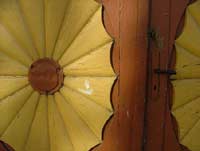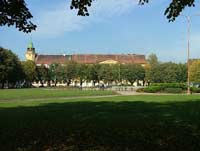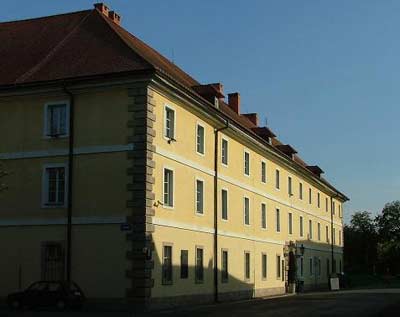Affordable travel in the Czech Republic |
Outside Prague |
| • Kutná Hora |
| • Litomyšl |
| • Olomouc |
| • Český Krumlov |
| • Karlovy Vary |
| • Mělník |
| • Kutná Hora |
| • Karlštejn castle |
| • Terezín |
| • Lidice |
| • Adršpach Rocks |
| • Bohemian Paradise |
| • České Budějovice |
| • Český Ráj |
| • Hradec Králové |
| • Liberec |
| • Plzeň |
| • Telč |
| Mikulov |
| Ostrava |

Ghetto Museum and the Large Fortress Terezín’s large fortress is so large that there’s a small town inside it. It was originally intended to house up to 11,000 soldiers but the former barracks now function as public or apartment buildings and the town has a population of around 3000 people. Museum of the Ghetto
Large fortress In contrast to the small fortress, which had for years been a prison, the large fortress was more like a town behind walls or an involuntary refugee camp. In the beginning the newly arrived Jews lived alongside the town’s original inhabitants, but by mid 1942, the original population had all been forced to move out. Terezín was apparently intended by the Nazis to be a marshalling, detention and transit centre for Jews, and a convenient propaganda tool. An active cultural life was encouraged and in this way the Nazis hoped to conceal the true extent and nature of their final solution from the prying eyes of the rest of the world for as long as possible. The appearance of a normal life
Jewish retirement village
First hand accounts The museum of the ghetto covers the cultural activities, propaganda uses and daily life of the ghetto in great detail. There’s also a section dedicated to the deception of the International Red Cross On June 23, 1944. Photographs, diaries, letters that escaped the censors and copies of artworks that somehow survived are used extensively as first-hand accounts of ghetto life. “We worked during the night. We took one body from the building to the barracks. Now there are corpses lying here amongst the living” “Nine people locked up for smuggling letters were hung” “Rooms are full of people, excrement, not enough eating utensils, the dead lie among the living for days” Transport to the camps The museum ends with an exhibit detailing the transport of Jews to places like Chelmno, Treblinka, Auschwitz and Majdanek. Of the 87,000 people deported to the east from Terezín only around 3600 survived.
|
 |
See and Do |
| • Terezín Overview |
| • Large fortress and Ghetto Museum |
| • Small fortress |
| • Prison Museum |
Eat, Drink and Sleep |
| • Check prices of Rooms in Prague |
| • Check prices of Rooms in Terezín |
| Getting there |
| • Getting to Terezín |
• Home •Blog• About• Contact• Sitemap •Links•
Outside Prague last updated June 13th, 2010. All text and images Copyright 2007-2010. Articles may be excerpted for review, or printed for use by individual travellers.
Complete articles or images may not otherwise be reproduced by print, electronic or other means.
 The main focus for tourists here is the Museum of the Ghetto. Formerly a school and during the Nazi years a boys’ home, the building now houses displays including original works of art from the ghetto and a detailed explanation of the way Terezín was used in 1944 to fool the International Red Cross into condoning the nazi’s treatment of the Jews. Entrance to the museum is 160Kč, but a combined ticket for all of Terezín’s monuments is 200Kč and will be the best choice for most people.
The main focus for tourists here is the Museum of the Ghetto. Formerly a school and during the Nazi years a boys’ home, the building now houses displays including original works of art from the ghetto and a detailed explanation of the way Terezín was used in 1944 to fool the International Red Cross into condoning the nazi’s treatment of the Jews. Entrance to the museum is 160Kč, but a combined ticket for all of Terezín’s monuments is 200Kč and will be the best choice for most people.  Cultural and artistic activities boosted the appearance of normal life amongst the ghetto’s Jews, and instead of direct orders from the nazi administrators of Terezín, a council of Jewish elders was set up to give the illusion of self-government. The Jewish council of course had to deliver the orders of their overlords, but those orders were given orally so that it could be claimed that the initiatives came from the councilors themselves.
Cultural and artistic activities boosted the appearance of normal life amongst the ghetto’s Jews, and instead of direct orders from the nazi administrators of Terezín, a council of Jewish elders was set up to give the illusion of self-government. The Jewish council of course had to deliver the orders of their overlords, but those orders were given orally so that it could be claimed that the initiatives came from the councilors themselves.  Early in the war Terezín was designated a ghetto for the aged and one of the bitterest tales is that of elderly Jews in Germany and Austria who were fooled or cajoled into signing over the deeds to their houses in exchange for guaranteed housing, board and medical support until the end of their lives. Something like a great Jewish retirement village. Imagine the disappointment and despair of the new arrivals when they found that their retirement village gave them only a slot in a hall filled with people on huge triple bunks like the shelves of a warehouse.
Early in the war Terezín was designated a ghetto for the aged and one of the bitterest tales is that of elderly Jews in Germany and Austria who were fooled or cajoled into signing over the deeds to their houses in exchange for guaranteed housing, board and medical support until the end of their lives. Something like a great Jewish retirement village. Imagine the disappointment and despair of the new arrivals when they found that their retirement village gave them only a slot in a hall filled with people on huge triple bunks like the shelves of a warehouse.